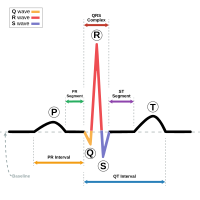
Photo from wikipedia
Background The European Society of Cardiology (ESC) guidelines for the management of adult congenital heart disease (ACHD) recommend screening in patients at risk for arrhythmic events. However, the optimal mode… Click to show full abstract
Background The European Society of Cardiology (ESC) guidelines for the management of adult congenital heart disease (ACHD) recommend screening in patients at risk for arrhythmic events. However, the optimal mode of detection is unknown. Methods Baseline and follow-up data of symptomatic ACHD patients who received an implantable loop recorder (ILR) or who participated in a smartphone based single-lead electrocardiogram study were collected. The primary endpoint was time to first detected arrhythmia. Results In total 116 ACHD patients (mean age 42 years, 44% male) were studied. The ILR group (n = 23) differed from the smartphone based single-lead electrocardiogram group (n = 93) in having a greater part of males and had more severe CHD and (near) syncope as qualifying diagnosis. In the smartphone based single-lead electrocardiogram group history of arrhythmia and palpitations were more frequent (all p < 0.05). Monitoring was performed for 40 and 79 patient-years for the ILR- and smartphone based single-lead electrocardiogram group, respectively. Arrhythmias occurred in 33 patients with an equal median time for both groups to first arrhythmia of 3 months (HR of 0.7, p = 0.81). Furthermore, atrial fibrillation occurred most often (n = 16) and common therapy changes included medication changes (n = 7) and implantation of pacemaker or Implantable Cardioverter Defibrillator (ICD) (N = 4). Symptoms or mode of detection were not a determinant of the first event. Conclusion Non-invasive smartphone based single-lead electrocardiogram monitoring could be an acceptable alternative for ILR implantation in detecting arrhythmia in symptomatic ACHD patients in respect to diagnostic yield, safety and management decisions, especially in those without syncope.
Journal Title: Frontiers in Cardiovascular Medicine
Year Published: 2023
Link to full text (if available)
Share on Social Media: Sign Up to like & get
recommendations!